Winter isn’t the only season with dangerous driving conditions. Driving in the rain is hazardous as well, particularly in the spring when showers are common.
Three-quarters of all weather-related crashes occur on wet pavement, according to the Federal Highway Administration, and nearly half happen during rainfall.
“A wet road is a treacherous road, even after a gentle sprinkle,” said Jillian Young, Director of Public Relations for AAA Northeast. “As little as 1/12 of an inch of water can cause new tires to lose traction with the road at speeds as low as 35 mph. When it rains, slow down and give yourself extra room to stop.”
Here is a closer look at driving in the rain and other spring-related driving challenges, with tips from AAA traffic safety experts on how to stay safe.
Hydroplaning
Hydroplaning – when a layer of water separates a vehicle’s tires from the ground and causes loss of traction, is one of the most dangerous situations caused by driving in the rain.
“When hydroplaning, you are literally riding on top of water without any control of your vehicle,” said AAA Car Doctor John Paul.
The first 10 minutes of a downpour present the highest risk for hydroplaning, which occurs when tires can’t displace enough water from their treads. Though it can happen with any tire and at any speed, it’s best to avoid driving on worn tires and to go slower in wet conditions to decrease your risk.
Follow these tips to avoid hydroplaning and maintain control of your car.
- Check your tire treads. Tires with fewer than 4/32 inches of tread should be replaced. You can check by inserting a quarter into a tread with Washington’s head facing down. If you can’t see the top of his head, the tire has at least 4/32 inches of tread.
- Inflate your tires to the manufacturer’s recommendations. Underinflated tires don’t have the same capacity for displacing water as tires that are properly inflated, making driving in the rain potentially more dangerous.
- Follow the leader. Try to drive in the tracks of the car in front of you for a clearer path.
- Leave extra room. A loss of traction can make it tougher to stop quickly. If you typically leave three seconds of space between you and the vehicle in front of you, Paul recommends adding one second for rain and two seconds for rain and darkness.
- Stay in the middle. If you’re on the highway, try to stay in the center lane. Many roadways have a crown that sends water to the right and left lanes.
- Avoid cruise control. If you have to slow down in wet weather, you’ll do so by taking your foot off the accelerator. But if cruise control is engaged, your foot is already off the accelerator. You want as much control as possible when driving in wet weather. Don’t give any away to cruise control.
- Stay calm. Your first reaction to hydroplaning might be to brake, but don’t do it. It won’t stop you. Instead, ease off the accelerator to decrease speed. Once your vehicle regains traction, look and steer in the direction you want to go.
Potholes
Potholes are another spring danger, the result of winter’s wrath on local roads. What’s worse, heavy rain can sometimes fill potholes, hiding them from view.
Striking potholes, even at low speeds, can be dangerous and expensive. A survey from AAA found that 1 in 10 drivers sustained vehicle damage significant enough to warrant a repair after hitting a pothole. With an average price tag of almost $600 per repair, damage caused by potholes cost drivers a staggering $26.5 billion.
“Snow, ice, sand and salt can leave roads in pretty bad shape, and the repeated freezing and thawing of moisture seeps through road surfaces and causes potholes,” said Barbara Ward, a traffic safety specialist with AAA Northeast. “Keep your eyes peeled for bad road conditions, but if you can’t avoid hitting a pothole, don’t brake during the pothole impact. Instead, apply the brakes just before hitting the pothole and release them just prior to impact. Less severe damage occurs when a tire is rolling than when it’s skidding over a hole during braking.”
Reduced Visibility
The harder it’s raining, the harder it is to see lane markings, signage and other vehicles. The situation can be even worse for drivers who neglect basic car care.
Remember these maintenance tips to keep your sight line clear while driving in the rain.
- Keep it clean. Maintaining visibility starts with keeping your windshield and windows clean. You’ll want to clean the insides of both regularly.
- Check your wiper blades. The average windshield wiper blade lasts about six months to a year. You can tell if a blade is starting to go if it leaves streaks behind.
- Use the defroster. Moisture inside a vehicle can create a fog on the windows. Paul recommends using defrosters with the air conditioning on and the vents open for fresh air. “Air conditioning, by design, dries the air,” he said.
- Turn on your lights. Your headlights are valuable equipment for battling low visibility when driving in the rain. You’ll want to turn them on even if you’re just passing through a light sun shower. It will help you see better, and a lot of states require drivers to turn on their headlights when using windshield wipers. While you may be tempted to go with the high beams, low beams are more effective during rain and fog. Don’t forget to periodically clean your headlights, too. Mud and dirt can cloud lenses, reducing illumination by up to 90%.
- Stop and wait. If it’s raining so hard that none of these steps alleviate visibility issues, it’s wise to find a safe place to pull over and wait until the weather lets up. Rest areas or protected areas off the highway are your best bets. If you must stop on the roadside, pull off the road as far as possible and turn your emergency flashers on to help other drivers see you.
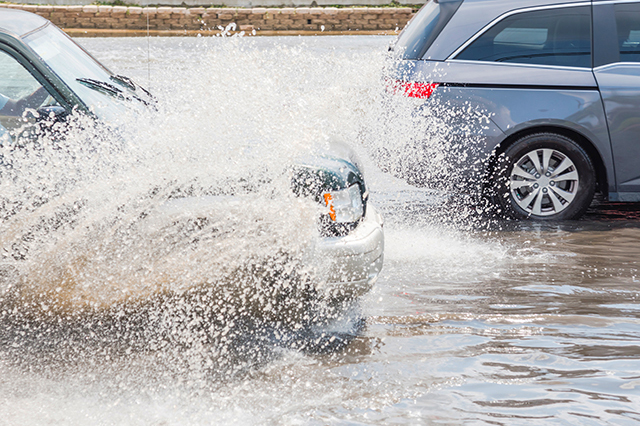
Deep Water
If you’re facing a storm that brings several inches of rain, it’s best to stay off the road when possible, and not just for your personal safety.
Vehicles traveling through water that’s deep enough to be pulled into the engine can suffer from hydrostatic lockup. In layman’s terms, that means the end of your engine, and even the most novice mechanic knows getting a new engine isn’t cheap.
If you have to traverse a deep puddle, do it as slowly as possible.
Drowsy Driving
Symptoms of sleepiness behind the wheel include not being able to keep your eyes open or focused, having trouble keeping your head up, daydreaming, having wandering thoughts, drifting among lanes or tailgating, yawning frequently, rubbing your eyes repeatedly, missing street signs or exits and feeling irritable or restless.
If you feel drowsy, find a safe place to park and take a break or a power nap. A quick bit of exercise and some caffeine can be helpful as well, according to the AAA Foundation for Traffic Safety.

Sun Glare
Longer days mean more sun, and greater chances of driving toward blinding light. Always slow down and use caution when dealing with strong sunlight.
Keep a pair of polarized sunglasses in the car to help reduce glare and use your car’s sun visors when needed. Regularly cleaning your windshield will also improve your view of the road, as streaks can be especially pronounced under strong sunlight.
Make sure to leave extra room between your vehicle and the one in front of it, especially during sunrise and sunset hours when the sun’s rays can make it harder to see the car in front of you. And if you are having trouble looking straight ahead, use the line markings on the street as your guide.
Medications
Spring can be a tough time for people affected by seasonal allergies. If you turn to over-the-counter allergy meds or use any prescription medications, talk to your doctor or pharmacist about potential side effects before getting behind the wheel.
Sharing the Road
Warm weather means more traffic from pedestrians, bicycles and motorcycles. As you would any time of year, always share the road safely. Stay hyperaware of your surroundings and avoid distractions.
Car Care
Winter can take a toll on vehicles, from reducing battery life to undercarriage corrosion caused by salt, sand and other road-cleaning chemicals. The first warm days of the season are a great time to inspect your vehicle, check its vitals and give it a good clean.
“While the application of de-icing salts and solutions is critical to keeping our nation’s roadways safe every winter, it’s important that drivers pay attention to warning signs that their vehicle may be suffering from rust-related damage,” Paul said. “This can be much more than a cosmetic issue; it can also create serious safety issues for drivers by impacting brake lines, exhaust systems, fuel tanks and electrical connections, as well as the structural integrity of some of these older vehicles on the road.”
You can limit damage by washing your vehicle throughout the winter. A spring clean and shine up will also make sure it is sparkling and well-protected.
If you have winter tires, replace them with all-season tires. Inspect the winter tires for any damage you’ll want to have repaired before next year.
Read more about how to get your car ready for the warmer months ahead.
Giving your car some TLC for spring? AAA members can save on automotive replacement parts and accessories at NAPA.
If you run into trouble on the road, due to rain or otherwise, call AAA Roadside Assistance or use your AAA Mobile app to get help.
This article has been updated and republished from a previous version.
9 Thoughts on “Driving in the Rain and Other Spring Driving Tips”
Leave A Comment
Comments are subject to moderation and may or may not be published at the editor’s discretion. Only comments that are relevant to the article and add value to the Your AAA community will be considered. Comments may be edited for clarity and length.



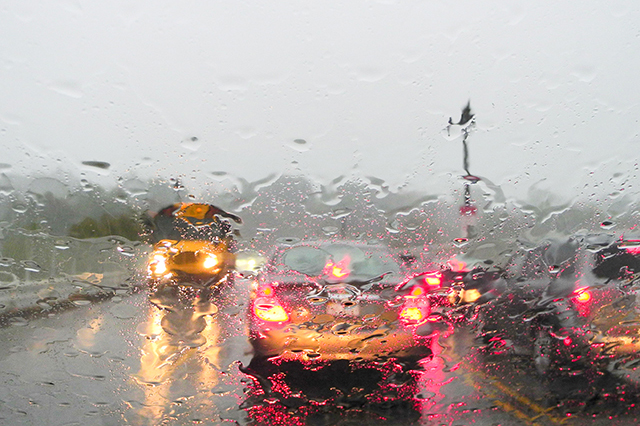


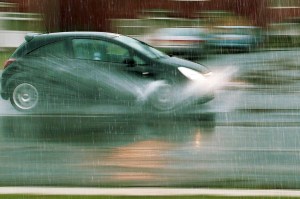



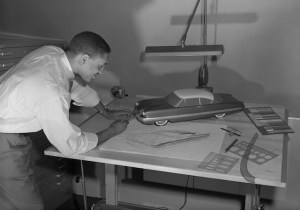

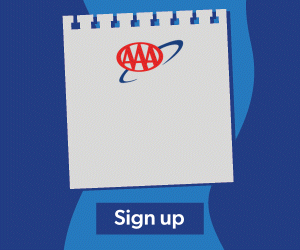


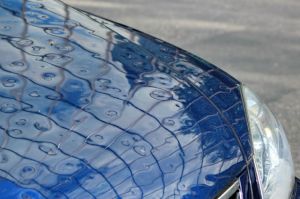
This is great advice. Thanks for this!!
One more thing we shouldn’t have to worry about, but we need to. Drivers are becoming increasingly lawless on the roads. It’s virtually impossible to follow speed limits without someone tailgating, swerving around and directly in front of you, or, as I have experienced many times on Long Island, passing over the double yellow line into oncoming traffic. Passing red lights and stop signs is rampant. Police have not been enforcing traffic safety as much since COVID and other binding issues. Constantly maintain situational awareness, not only in front, but sideways, backways and even overhead (A friend of ours was once struck by a deer that jumped off an overpass, seriously injuring her daughter). Lastly, follow William’s advise above. I have been using amber baush and Lomb sunsensors for many years. I don’t think these are made anymore, but even the simple “As Seen on TV” glasses improve vision on misty roads, and reduce glare from oncoming headlights at night.
I was driving in southwest Florida in a late afternoon thunderstorm, referred to locally as a “frog strangler.” Visibility was so low that I had slowed dramatically. I only put them on because I had them in the car, a pair of yellow lens glasses. My visibility improved dramatically; I could see that I was following an 18 wheeler at about three car lengths. I no longer travel without them. They improve visibility and reduce stress and fatigue.
All of this is awesome information thank you AAA. Keep it coming.
What’s the best way to clean the windsheild?
Hi there!
Here’s some basic information from AAA on cleaning your windshield. I hope this is helpful!
Keep it clean. Use non-ammonia cleaners with soft cotton or microfiber towels to remove road grime and dirt without causing streaks. Avoid ammonia-based and abrasive cleaners, especially if your car has aftermarket window tinting. These products can scratch and may cause tint films to peel.
-Dana
THANK YOU & HAPPY EASTER
Great information — Good to get a refresher often
When it is raining heavily and difficult to see the road, wearing your sunglasses allows you to see much more clearly. I read that advice several years ago and have been following it ever since.